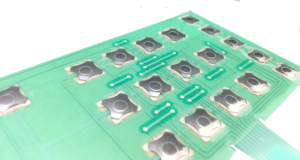The Function of a Membrane Switch in Modern Touch Interfaces and Controls
The Function of a Membrane Switch in Modern Touch Interfaces and Controls
Blog Article
Recognizing the Capability of Membrane Layer Changes for User User Interface Instruments
The functionality of membrane switches over stands for a significant innovation in individual interface layout, combining effectiveness with visual adaptability. As markets progressively focus on user experience, comprehending the subtleties of membrane button technology comes to be vital.
What Are Membrane Layer Buttons?
Membrane layer switches are ingenious user interface tools that assist in individual interaction with electronic devices. These functional components consist of multiple layers, including a graphic overlay, spacer, and a printed circuit layer. The design permits a seamless assimilation into different electronic gadgets, improving both the aesthetic and functional elements of individual interfaces.
Membrane buttons are typically utilized in a broad range of applications, from house appliances to industrial equipment and clinical tools. Their building and construction typically includes a thin account, making them an optimal option for small designs. The tactile feedback supplied by these switches can be engineered to fulfill details customer preferences, guaranteeing efficient communication between the customer and the gadget.
Longevity is an additional considerable advantage of membrane buttons, as they are immune to dust, moisture, and chemicals, which boosts their life expectancy sought after environments. In addition, these switches can be tailored in regards to shape, size, and graphic design, enabling branding and user-specific attributes. Generally, membrane switches over represent a practical remedy for boosting individual experience in electronic gadgets, combining capability with aesthetic allure in an effective way.
Just How Membrane Switches Over Work
Operating on a straightforward concept, membrane switches over use a split building and construction to register individual input properly. Each switch contains several layers, consisting of a printed circuit layer, a spacer layer, and a leading visuals layer, which are developed to collaborate flawlessly. When a customer presses the leading layer, it compresses the spacer layer, bringing the conductive components of the circuit layer into call with each various other.
This call produces a shut circuit, signaling the gadget to implement a particular feature. The design enables various setups, consisting of tactile comments, which can improve the customer experience by offering a physical experience upon activation. The materials used in membrane layer buttons frequently include versatile substratums, such as polyester or polycarbonate, which guarantee longevity and resilience against deterioration.

Trick Benefits of Membrane Layer Switches

An additional substantial advantage is their density. Membrane layer switches are slim and lightweight, which enables suppliers to conserve space in their tools without compromising functionality. This attribute is particularly advantageous in applications where weight and quantity are crucial factors to consider.
Additionally, membrane layer switches are immune to dirt, dampness, and chemicals, improving their durability. This strength extends their life-span and decreases the demand for regular substitutes, resulting in expense savings in time.
Moreover, the tactile responses offered check by membrane buttons can be optimized to improve user interaction. They can consist of features such as increased switches or distinct clicks, enhancing use and user experience.
Applications Throughout Industries
User interface tools utilizing membrane buttons prevail in a broad variety of sectors, showcasing their adaptability and performance. Membrane Switch. In the clinical sector, membrane buttons are indispensable to devices such as diagnostic tools and patient monitoring systems, where their toughness and simplicity of cleansing are essential for preserving health criteria. Similarly, in the automobile market, these buttons are employed in dashboard controls and infotainment systems, supplying a streamlined and modern-day user interface for customers.
Furthermore, the consumer electronics sector gain from membrane buttons in appliances and portable tools, where compact design and user-friendly interfaces enhance user experience. Industrial applications also leverage membrane layer switches over for control panels in equipment and automation systems, highlighting their toughness and resistance to rough settings.
In the aerospace and defense sectors, membrane switches are used in cabin controls and tools, where dependability and performance under extreme problems are vital. Additionally, the video gaming market progressively integrates membrane buttons in controllers and game machines, adding to an appealing customer experience. On the whole, the adaptability of membrane changes allows their extensive use throughout many industries, emphasizing their relevance in contemporary individual interface layout.
Future Fads in Membrane Switch Over Innovation

Furthermore, the usage of innovative materials, such as polycarbonate and polyester films, is anticipated to climb, providing improved resilience and resistance to ecological stress factors. These materials visit this site right here contribute to the general long life of membrane layer buttons, making them suitable for harsher industrial applications.
Moreover, the consolidation of wise modern technology, consisting of IoT connectivity, will enable membrane switches to interact with various other tools and systems, helping with a much more interactive individual experience. This pattern lines up with the expanding need for smart gadgets throughout different fields, from medical care to customer electronic devices.
Last but not least, modification alternatives are expected to broaden, allowing makers to develop bespoke remedies tailored to particular individual needs and preferences. These developments will place membrane layer buttons as vital components in the advancement of customer interface modern technology.
Verdict
In verdict, membrane layer changes represent a pivotal improvement in interface innovation, providing a dependable and versatile remedy for varied electronic applications. Their layered construction promotes small design, while attributes such as tactile comments enhance customer communication. The durability versus environmental factors better solidifies their energy across multiple sectors. As developments in material science and touch sensing modern technologies continue, the capability and applicability of membrane buttons are expected to expand, enhancing their relevance in modern electronic tools.
Report this page